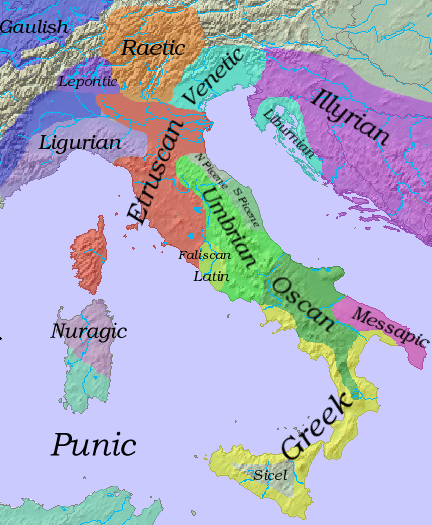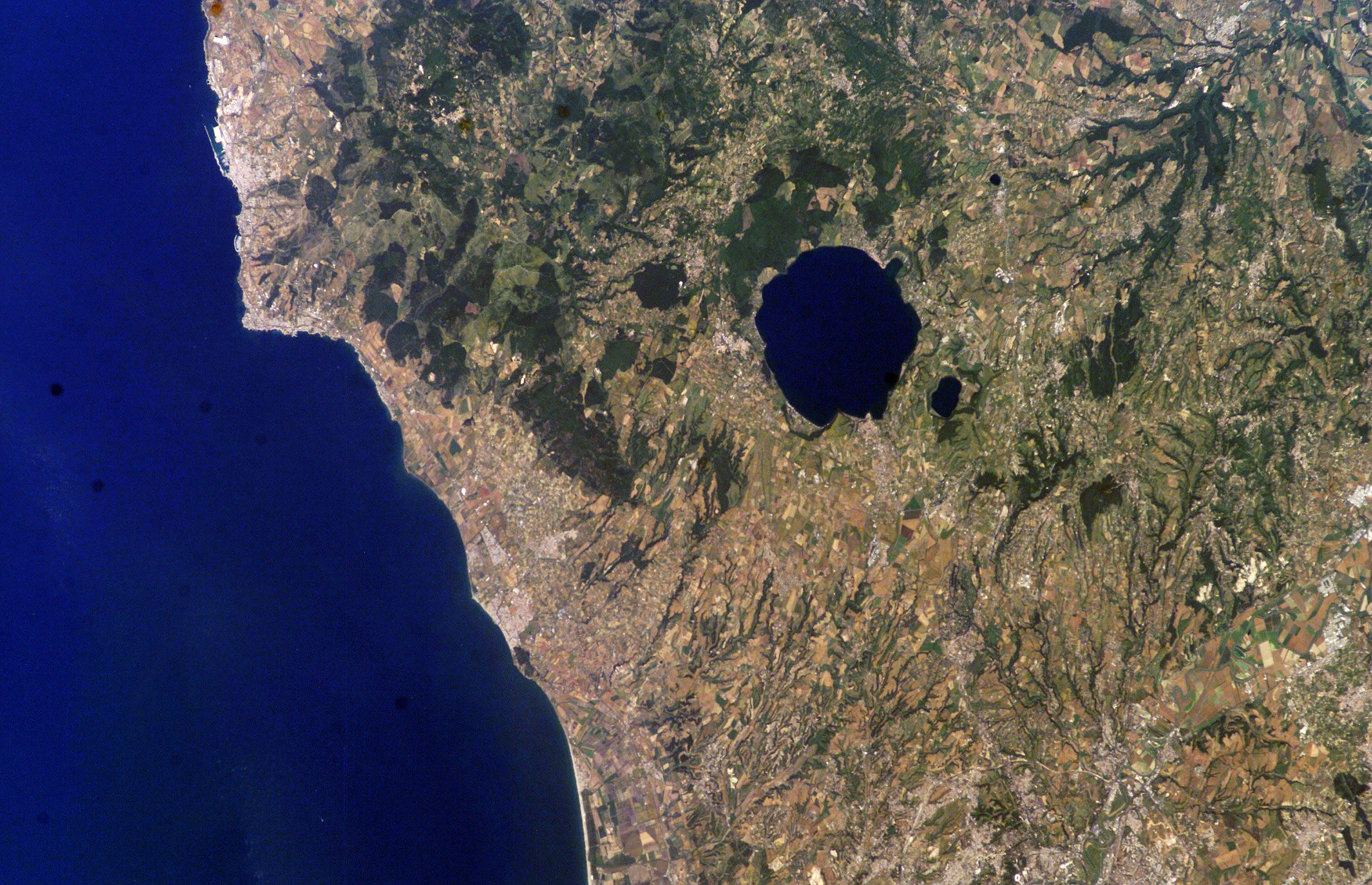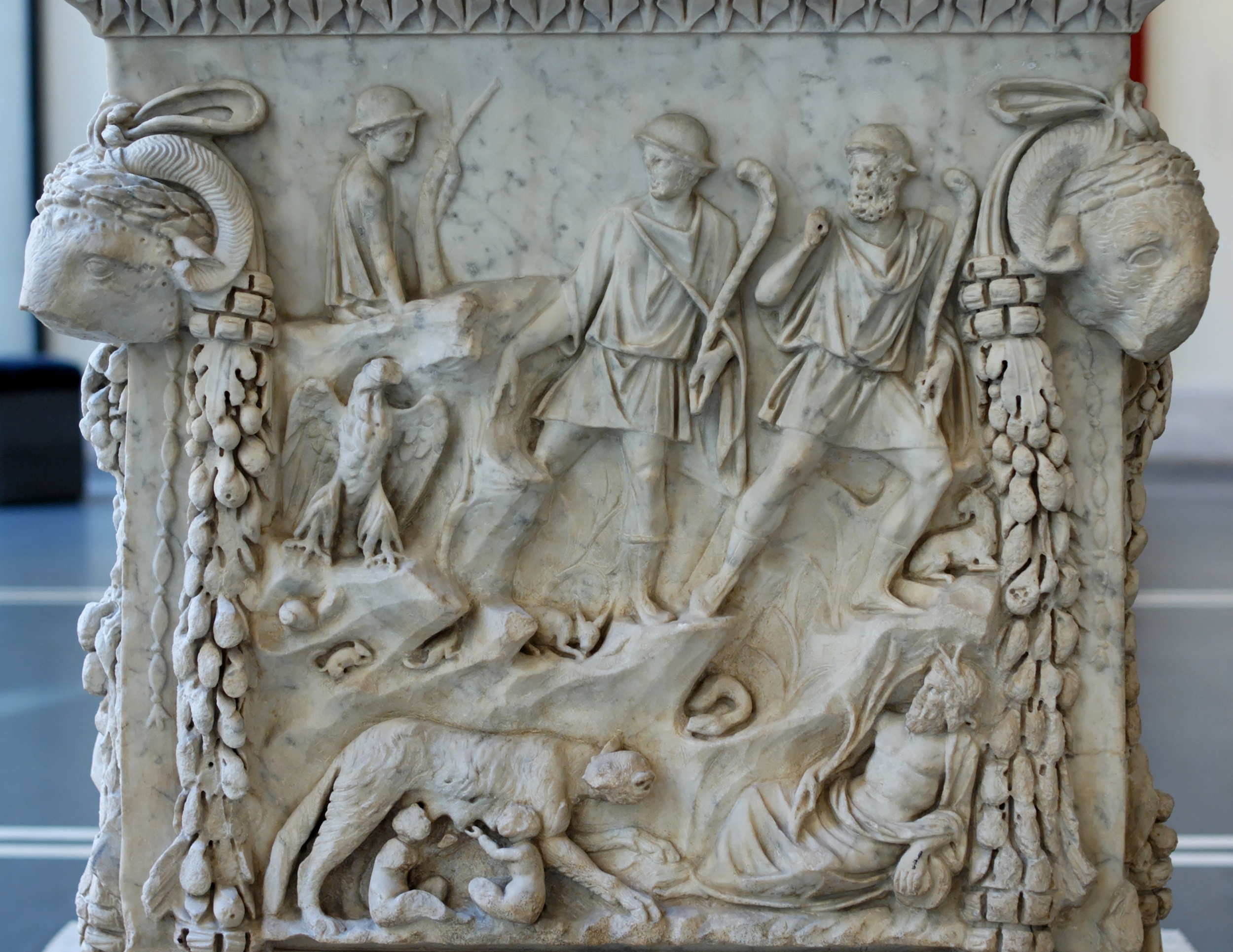|
Falisci
The Falisci were an Italic peoples, Italic tribe who lived in what is now northern Lazio, on the Etruscan side of the Tiber River. They spoke an Italic languages, Italic language, Faliscan language, Faliscan, closely related to Latin. Originally a sovereign state, politically and socially they supported the Etruscan civilization, Etruscans, joining the Etruscan League. This conviction and affiliation led to their ultimate near destruction and total subjugation by Rome. Only one instance of their own endonym has been found to date: an inscription from Falerii Novi from the late 2nd century AD refers to the ', "the Faliscans who are in Sardinia", where ' is the nominative plural case. An Etruscan inscription calls them the '. The Latin cannot be far different from the original name. The -sc- suffix is "distinctive of the Italic ethnonyms". Geography The Falisci resided in a region called by the Romans the ', "Faliscan Country", located on the right bank of the Tiber River betwe ... [...More Info...] [...Related Items...] OR: [Wikipedia] [Google] [Baidu] [Amazon] |
Faliscan Language
The Faliscan language is the extinct Italic language of the ancient Falisci, who lived in southern Etruria at Tiber Valley. Together with Latin, it formed the Latino-Faliscan languages group of the Italic languages. It seems probable that the language persisted, being gradually permeated with Latin, until at least 150 BC. Corpus An estimated 355 inscriptions survive, mostly short and dating from the 7th to the 2nd centuries BC. Some are written from right to left in a variety of the Old Italic alphabet, derived from the Etruscan alphabet, but they show some traces of the influence of the Latin alphabet. An inscription to Ceres of c. 600 BC, found in Falerii, usually taken to be the oldest example, is written left to right. A specimen of the language appears written around the edge of a picture on a patera, the genuineness of which is established by the fact that the words were written before the glaze was put on: ', . That sample indicates that Faliscan was less conserv ... [...More Info...] [...Related Items...] OR: [Wikipedia] [Google] [Baidu] [Amazon] |
Monte Soratte
Monte Soratte (ancient: ''Soracte'') is a mountain ridge in the Metropolitan City of Rome, central Italy. It is a narrow, isolated limestone ridge with a length of and six peaks. Located some south east of Civita Castellana and c. north of Rome, it is the sole notable ridge in the Tiber Valley, geologically represents the Meso-cenozoic Tiber ridge. The nearest settlement is the village of Sant'Oreste. Saint Orestes or Edistus, after whom the settlement is named, is said to have been martyred near Monte Soratte. The highest summit is above sea-level. The ridge is part of a Natural Reserve housing a variety of vegetation and fauna. It is also characterized by the so-called ''Meri'', pits which can be up to deep. History and sights Mount Soratte is a sacred mountain of the Falisci (consecrated to their corresponding divinity: the Pater Soranus). It's probably the etymology of the name. The area was used by the ancient Italic peoples of the area ( Etruscan, Falisci, Cape ... [...More Info...] [...Related Items...] OR: [Wikipedia] [Google] [Baidu] [Amazon] |
Capena
Capena (until 1933 called Leprignano) is a town and ''comune'' in the Metropolitan City of Rome, Lazio region (central Italy). The town has borrowed its modern name from a pre-Roman and Roman settlement that was to its north. Geography Capena is located north of Rome (as the crow flies), above the valley of the Tiber. The old quarter stands on a hill overlooking the valley of the Fosso di Morlupo to the west, while the modern district extends into the eastern plain. The neighbouring towns are Castelnuovo di Porto, Civitella San Paolo, Fiano Romano, Monterotondo, Morlupo and Rignano Flaminio. History Ancient era The original Capena occupied the plateau of a nowadays uninhabited hill called La Civitucola, which is about northeast of a post station on the ancient ''Via Flaminia''. Its territory was known in ancient times as the ''Ager Capenas'', which was a Faliscan area adjacent (and culturally allied) to Etruria. It is frequently mentioned alongside of Veii, Falerii an ... [...More Info...] [...Related Items...] OR: [Wikipedia] [Google] [Baidu] [Amazon] |
Monti Sabatini
The Monti Sabatini is a geologic region in Lazio, central Italy, a remnant of intense volcanism which started ca. 600,000 years ago, mainly with pyroclastic and maar forming eruptions which continued until 100,000 years ago. The region is classified as a dormant volcanic district. The mountains are part of the Lazio's Anti-Apennines. Included between the Monti Sabatini is the Lake Bracciano, which is a volcanotectonic depression formed about 3.7 Ma, and the Lake Martignano. The sedimentary base of the Sabatini complex lies buried under of volcanic ash Volcanic ash consists of fragments of rock, mineral crystals, and volcanic glass, produced during volcanic eruptions and measuring less than 2 mm (0.079 inches) in diameter. The term volcanic ash is also often loosely used to r ... and rocks. Background The highest point is Monte Rocca Romana (a postcaldera stratocone), at . Other mountains in the area include Monti della Tolfa, Monte Sor ... [...More Info...] [...Related Items...] OR: [Wikipedia] [Google] [Baidu] [Amazon] |
Monti Cimini
The Monti Cimini, in English: Cimini Hills, are a range of densely wooded volcanic hills approximately north-west of Rome. They are part of the Antiapennine range, facing the Apennines main range towards the Tyrrhenian Sea. They are situated in the centre of Tuscia Viterbese, the highest point at Mount Cimino, above sea level. Lake Vico, a volcanic crater lake, is situated in the hills. Background The vegetation is predominantly beech forestation. The area is renowned for its hot springs, renaissance villa A villa is a type of house that was originally an ancient Roman upper class country house that provided an escape from urban life. Since its origins in the Roman villa, the idea and function of a villa have evolved considerably. After the f ...s and Etruscan ruins. See also * Lake Vico References Cimini, Monti Cimini Cimini Falisci Stratovolcanoes of Italy Lava domes {{Lazio-geo-stub ... [...More Info...] [...Related Items...] OR: [Wikipedia] [Google] [Baidu] [Amazon] |
Lake Bracciano
Lake Bracciano () is a lake of volcanic origin in the Italian region of Lazio, northwest of Rome. It is the second largest lake in the region (second only to Lake Bolsena) and one of the major lakes of Italy. It has a circular perimeter of approximately . Its inflow is from precipitation runoff and percolation, and from underground springs, and its outflow is the Arrone. The lake owes its origin to intense volcanic and tectonic activity from 600,000 to 40,000 years ago, which created many small volcanoes in the ''Sabatino'' territory. The main magma chamber was situated under the present lake of Bracciano. Its collapse created the depressed area now occupied by the lake, which is not a crater lake. Some small craters and calderas are still recognisable around the lake and in the immediate vicinity (Martignano, Baccano, Sacrofano). Three towns border the lake, Bracciano, Anguillara Sabazia and Trevignano Romano. The lake is an important tourist attraction. As it serves as a ... [...More Info...] [...Related Items...] OR: [Wikipedia] [Google] [Baidu] [Amazon] |
Iron Age Italy
The prehistory of Italy began in the Paleolithic period, when members of the genus ''Homo species, Homo'' first inhabited what is now modern Italian territory, and ended in the Iron Age, when the first written records appeared in Insular Italy, Italy. Paleolithic In prehistoric times, the landscape of the Italian Peninsula was significantly different from its modern appearance. During glaciations, for example, the sea level was lower and the islands of Elba and Sicily were connected to the mainland. The Adriatic Sea began at what is now the Gargano, Gargano Peninsula, and what is now its surface up to Venice was a fertile plain with a humid climate. The arrival of the first known hominins was 850,000 years ago at Monte Poggiolo. The presence of ''Homo neanderthalensis'' has been demonstrated in archaeological findings dating to c. 50,000 years ago (late Pleistocene). There are about 20 unique sites, the most important being that of the Grotta Guattari at San Felice Circeo, on ... [...More Info...] [...Related Items...] OR: [Wikipedia] [Google] [Baidu] [Amazon] |
Lake Vico
Lake Vico (, ) is a caldera lake in northern Lazio, central Italy. It is one of the highest major Italian lakes, with an altitude of 510 m. Administratively, it is part of the municipalities of Caprarola and Ronciglione. The lake is surrounded by the Cimini Hills, in particular by the Fogliano (965 m) and Venere (851 m) mountains. It is part of the Lake Vico Natural Reserve. According to legend, the lake was created by Hercules, who defied the local inhabitants by wielding his club. When he did this, a stream sprang up and formed the lake. Geology Lake Vico occupies the central caldera of Vico Volcano. A volcanic cone was built up in a series of eruptions that occurred 305,000 to 258,000 years ago. Later, the eruption of voluminous pyroclastic flows, and volcanic ash, caused the progressive collapse of the volcanic cone, which created the caldera, in which Lake Vico now lies, by about 138,000 years ago.Locardi, E. (1965) ''Tipi ignimbritici di magmi medit ... [...More Info...] [...Related Items...] OR: [Wikipedia] [Google] [Baidu] [Amazon] |
From The Founding Of The City
The ''History of Rome'', perhaps originally titled , and frequently referred to as (), is a monumental history of ancient Rome, written in Latin between 27 and 9 BC by the Roman historian Titus Livius, better known in English as "Livy". The work covers the period from the legends concerning the arrival of Aeneas and the refugees from the fall of Troy, to the city's founding in 753 BC, the expulsion of the Kings in 509 BC, and down to Livy's own time, during the reign of the emperor Augustus. The last event covered by Livy is the death of Drusus in 9 BC. 35 of 142 books, about a quarter of the work, are still extant. The surviving books deal with the events down to 293 BC (books 1–10), and from 219 to 166 BC (books 21–45). Contents Corpus The ''History of Rome'' originally comprised 142 "books", 35 of which—Books 1–10 with the Preface and Books 21–45—still exist in reasonably complete form. Damage to a manuscript of the 5th century resulted in ... [...More Info...] [...Related Items...] OR: [Wikipedia] [Google] [Baidu] [Amazon] |
Livy
Titus Livius (; 59 BC – AD 17), known in English as Livy ( ), was a Roman historian. He wrote a monumental history of Rome and the Roman people, titled , covering the period from the earliest legends of Rome before the traditional founding in 753 BC through the reign of Augustus in Livy's own lifetime. He was on good terms with members of the Julio-Claudian dynasty and was a friend of Augustus. Livy encouraged Augustus’s young grandnephew, the future emperor Claudius, to take up the writing of history. Life Livy was born in Patavium in northern Italy, now modern Padua, probably in 59 BC. At the time of his birth, his home city of Patavium was the second wealthiest on the Italian peninsula, and the largest in the province of Cisalpine Gaul (northern Italy). Cisalpine Gaul was merged into Italy proper during his lifetime and its inhabitants were given Roman citizenship by Julius Caesar. In his works, Livy often expressed his deep affection and pride for Patavium, and the ... [...More Info...] [...Related Items...] OR: [Wikipedia] [Google] [Baidu] [Amazon] |
From The Founding Of The City/Book 9
{{disambig ...
From may refer to: People *Isak From (born 1967), Swedish politician *Martin Severin From (1825–1895), Danish chess master * Sigfred From (1925–1998), Danish chess master Media * ''From'' (TV series), a sci-fi-horror series that debuted on Epix in 2022 * "From" (Fromis 9 song) (2024) * "From", a song by Big Thief from U.F.O.F. (2019) * "From", a song by Yuzu (2010) * "From", a song by Bon Iver from Sable, Fable (2025) Other * From, a preposition * From (SQL), computing language keyword * From: (email message header), field showing the sender of an email * FromSoftware, a Japanese video game company * Full range of motion, the travel in a range of motion Range of motion (or ROM) is the linear or angular distance that a moving object may normally travel while properly attached to another. In biomechanics and strength training, ROM refers to the angular distance and direction a joint can move be ... [...More Info...] [...Related Items...] OR: [Wikipedia] [Google] [Baidu] [Amazon] |
Via Tiburtina
Via Tiburtina is an ancient road in Italy leading east-northeast from Rome to Tivoli (Latin: Tibur) and then, with the Via Valeria, on to Pescara (Latin: Aternum). Historical road It was probably built by the Roman censor Marcus Valerius Maximus in 307 BCPiraino C. 2004: "The via Valeria and the centuriation", in Lapenna s. (ed.), The Aequi between Abruzzo and Lazio, Chieti, 115-118. at the time of the conquest of the Aequi territory and later lengthened, probably in about 154 BC, by Marcus Valerius Messalla to the territories of the Marsi and the Aequi in the Abruzzo, as Via Valeria. Its total length was approximately 200 km from Rome to Aternum (the modern Pescara). It exited Rome through the Aurelian Walls at the Porta Tiburtina, and through the Servian Wall at the Porta Esquilina. Historians assert that the Via Tiburtina must have come into existence as a trail during the establishment of the Latin League. It is difficult to determine the part of the cou ... [...More Info...] [...Related Items...] OR: [Wikipedia] [Google] [Baidu] [Amazon] |









